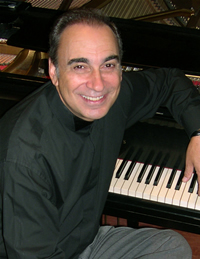The not-yet-thirty-year-old Japanese pianist Hiromi Uehara appeared in concert under the auspices of NCSU Center Stage at Stewart Theatre. Hiromi (as she is billed) presents herself as a girl-child, wearing shiny satin boxers with tights, plus sneakers, and speaking in a little tiny high voice (not so different, I imagine, from the majority of Japanese women in their twenties, when they are not at their corporate jobs). Some listeners might find this off-putting, but as soon as she started to play, my attention was focused on the sounds coming out of the Steinway piano.
The fact that Hiromi’s origins are in classical music are evident in the quality of her technique, which is absolutely masterful, with an amazing control of touch and dynamics, and, I would say, in what she chooses to play. All jazz is a combination of pre-composed material and extemporaneous improvisation. But in Hiromi’s case it sounds like more than simply the tune and changes are composed; she includes swathes of how these are developed.
Hiromi presented two forty-five minute sets, separated by a twenty-minute interval. The show began when she bounded out to play “Rhythm” changes, and finally played the actual melody itself (all jazz musicians play the changes, but usually they compose another melody to go on top). Her interpretation included some stride-piano stylings, another old-fashioned touch. The sheer volume of notes, and the exuberance with she played, won the audience over immediately. She announced her next two numbers “Sicilian Blue” and “BQE,” the latter with the amount of spikiness and activity that you would expect from a musical depiction of the Bronx-Queens Expressway. These were followed by a rather-too-cute impression of the Pachelbel Canon, complete with piano-prepared-to-sound-like-harpsichord (I can’t imagine this getting past the ears of someone like Mingus or Miles Davis without acerbic commentary.) She closed the first-half with an original blues, “Cream Puff.”
Her second half began with a pensive, Satie-esque number, “Place to Be,” another blues “Cape Cod Chips,” (her favorite snack while studying in Boston), a lovely ballad, “Somewhere,” and a suite, Las Vegas, subdivided into “Showgirls,” “Daytime in Las Vegas,” and “The Gambler.” The audience rewarded her with a standing ovation, and was treated to “Green Tea Farm,” another ballad, as encore.
Hiromi has simply astounding chops, and the detail of her improvisations is highly inventive, with complex patterns repeating at high speed. Musically, however, one might argue that what she plays continues to be derivative and immature, even several decades behind the times, like those devotees who played Dixieland while Coltrane was making his innovations. Her universe of influences seems to be highly restricted, including innovators neither from classical music or jazz. If she continues to mature, and opens her ears, she certainly has the talent and musicianship to make a real and original contribution.












